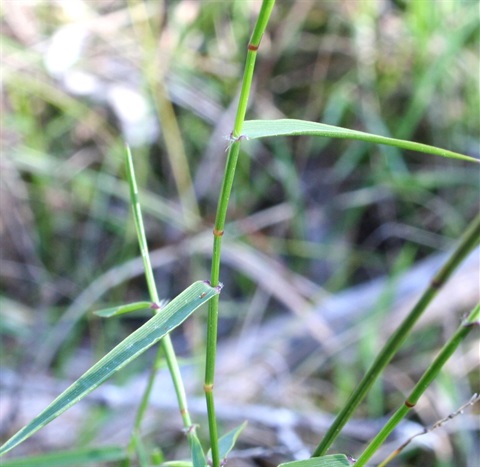
Tetrarrhena juncea
Forest Wire-grass
Wiry, many-branched trailing or climbing perennial rooting at nodes and from underground stems. Stems rough from backward facing bristles.
Additional information
- FamilyPoaceae
- StoreyLower storey
- Sizestems 2-5 m long
- Plant groupingGrasses, Rushes & Sedges
- LeavesFlat rough leaves 1-8 cm x 2-5 mm, distantly scattered along stems, sometimes absent from lower stems.
- Flower colourPurplish
- Flowering timeNovember to April
- Flowers5-16 1-flowered spikelets in a spike-like flowerhead 2-7 cm long; spikelet 4.5-6.5 mm, sterile floral bract blunt.
- Bird attractingNo
- Butterfly attractingFood plant for caterpillars
- Frog habitatNo
- Growing conditionsMoist soils, tolerating drying out in summer, in gullies and moist to wet forests and heathy woodlands. Semi shade to full shade.
- Garden useCreates a rough tangled mass which will climb on shrubs and plants. Excellent habitat plant. Wombats eat the roots. Will need management in a garden situation.
- Commercially availableIndigenous nursery
- Conservation statusWidespread within the Shire
- Related speciesTetrarrhena acuminata can be distinguished by the longer spikelets, from 7 mm which have raised veins & tapering upper sterile floral bract (cf blunt bracts in above species).
Photo Gallery
Photographer/s: 1, 2 Yarra Ranges Council photo library; 3, 4 Marilyn Bull ©
Plant Communities